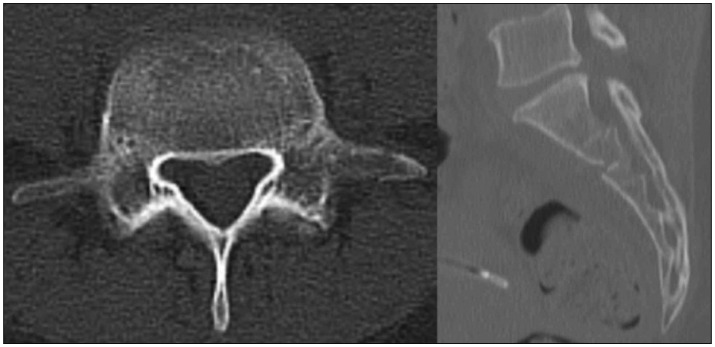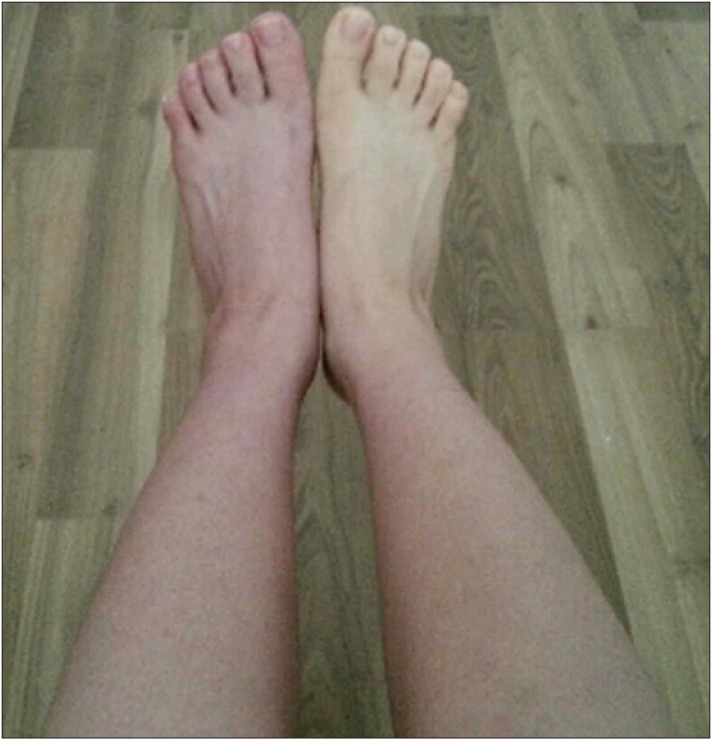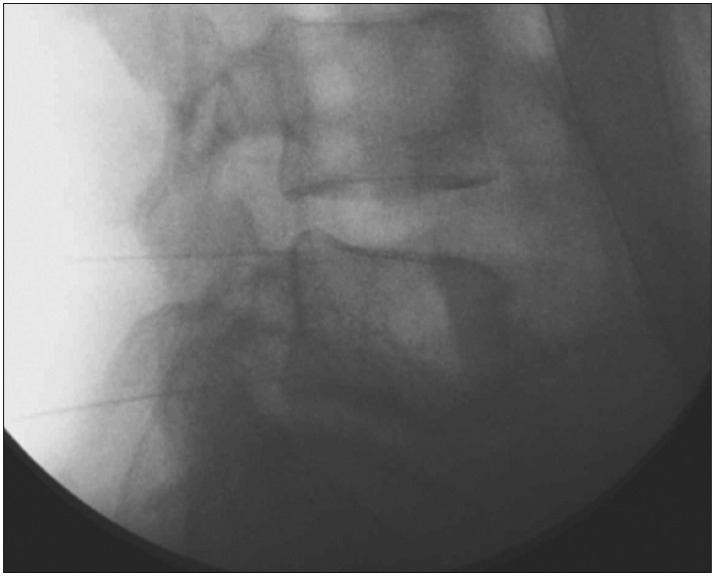J Korean Neurosurg Soc.
2016 Sep;59(5):529-532. 10.3340/jkns.2016.59.5.529.
Treatment for Acute Stage Complex Regional Pain Syndrome Type II with Polydeoxyribonucleotide Injection
- Affiliations
-
- 1Department of Neurosurgery, SunHan Hospital, Gwangju, Korea. deme2000@naver.com
- KMID: 2351725
- DOI: http://doi.org/10.3340/jkns.2016.59.5.529
Abstract
- Complex regional pain syndrome (CRPS) type II is a syndrome that develops after nerve injury. Symptoms may be severe, and vary depending on the degree of sympathetic nerve involvement. As yet, there is no satisfactory treatment. We report the case of a female patient who had an L5 left transverse process fracture and an S2 body fracture, who developed symptoms of CRPS type II in her left lower leg that were aggravated during ambulation in spite of absolute bed rest for one month after the trauma. Several treatments, including bed rest, medication, and numerous nerve blocks were attempted, but the pain persisted. We finally tried injection of polydeoxyribonucleotide (PDRN) solution at the left L5 transverse process fracture site because we knew of the anti-inflammatory effect of PDRN. One day after this treatment, her symptoms had almost disappeared and three days later, she was discharged. We will also further discuss the possibility of using PDRN solution for the treatment of CRPS.
MeSH Terms
Figure
Reference
-
1. Altavilla D, Bitto A, Polito F, Marini H, Minutoli L, Di Stefano V, et al. Polydeoxyribonucleotide (PDRN) : a safe approach to induce therapeutic angiogenesis in peripheral artery occlusive disease and in diabetic foot ulcers. Cardiovasc Hematol Agents Med Chem. 2009; 7:313–321. PMID: 19860658.
Article2. Bitto A, Galeano M, Squadrito F, Minutoli L, Polito F, Dye JF, et al. Polydeoxyribonucleotide improves angiogenesis and wound healing in experimental thermal injury. Crit Care Med. 2008; 36:1594–1602. PMID: 18434887.
Article3. Bitto A, Oteri G, Pisano M, Polito F, Irrera N, Minutoli L, et al. Adenosine receptor stimulation by polynucleotides (PDRN) reduces inflammation in experimental periodontitis. J Clin Periodontol. 2013; 40:26–32. PMID: 23033941.
Article4. Bitto A, Polito F, Irrera N, D'Ascola A, Avenoso A, Nastasi G, et al. Polydeoxyribonucleotide reduces cytokine production and the severity of collagen-induced arthritis by stimulation of adenosine A(2A) receptor. Arthritis Rheum. 2011; 63:3364–3371. PMID: 21769841.
Article5. Bruehl S. An update on the pathophysiology of complex regional pain syndrome. Anesthesiology. 2010; 113:713–725. PMID: 20693883.
Article6. Carroll I, Curtin CM. Management of chronic pain following nerve injuries/CRPS type II. Hand Clin. 2013; 29:401–408. PMID: 23895720.
Article7. Galeano M, Bitto A, Altavilla D, Minutoli L, Polito F, Calò M, et al. Polydeoxyribonucleotide stimulates angiogenesis and wound healing in the genetically diabetic mouse. Wound Repair Regen. 2008; 16:208–217. PMID: 18318806.
Article8. Harden RN, Oaklander AL, Burton AW, Perez RS, Richardson K, Swan M, et al. Complex regional pain syndrome : practical diagnostic and treatment guidelines, 4th edition. Pain Med. 2013; 14:180–229. PMID: 23331950.
Article9. Kemler MA, de Vet HC, Barendse GA, van den Wildenberg FA, van Kleef M. Effect of spinal cord stimulation for chronic complex regional pain syndrome Type I : five-year final follow-up of patients in a randomized controlled trial. J Neurosurg. 2008; 108:292–298. PMID: 18240925.
Article10. Kim WJ, Shin HY, Koo GH, Park HG, Ha YC, Park YH. Ultrasound-guided prolotherapy with polydeoxyribonucleotide sodium in ischiofemoral impingement syndrome. Pain Pract. 2014; 14:649–655. PMID: 24734999.
Article11. Maihöfner C, Seifert F, Markovic K. Complex regional pain syndromes : new pathophysiological concepts and therapies. Eur J Neurol. 2010; 17:649–660. PMID: 20180838.
Article12. Minutoli L, Arena S, Bonvissuto G, Bitto A, Polito F, Irrera N, et al. Activation of adenosine A2A receptors by polydeoxyribonucleotide increases vascular endothelial growth factor and protects against testicular damage induced by experimental varicocele in rats. Fertil Steril. 2011; 95:1510–1513. PMID: 20797711.
Article13. Price DD, Long S, Wilsey B, Rafii A. Analysis of peak magnitude and duration of analgesia produced by local anesthetics injected into sympathetic ganglia of complex regional pain syndrome patients. Clin J Pain. 1998; 14:216–226. PMID: 9758071.
Article14. Taylor RS, Van Buyten JP, Buchser E. Spinal cord stimulation for complex regional pain syndrome : a systematic review of the clinical and cost-effectiveness literature and assessment of prognostic factors. Eur J Pain. 2006; 10:91–101. PMID: 16310712.15. Vincenzi F, Padovan M, Targa M, Corciulo C, Giacuzzo S, Merighi S, et al. A(2A) adenosine receptors are differentially modulated by pharmacological treatments in rheumatoid arthritis patients and their stimulation ameliorates adjuvant-induced arthritis in rats. PLoS One. 2013; 8:e51495.
Article
- Full Text Links
- Actions
-
Cited
- CITED
-
- Close
- Share
- Similar articles
-
- Clinical Experience of a Complex Regional Pain Syndrome Type II Patient: A case report
- Diagnosis of complex regional pain syndrome
- Anti-Allodynic Effects of Polydeoxyribonucleotide in an Animal Model of Neuropathic Pain and Complex Regional Pain Syndrome
- The Effect of Intravenous Regional Block with Ropivacaine, Ketamine and Clonidine on Complex Reginal Pain Syndrome Type I: A case report
- Clinical Experience of a Complex Regional Pain Syndrome II after Neurectomy of Medial Gastrocnemius Muscle: A case report




